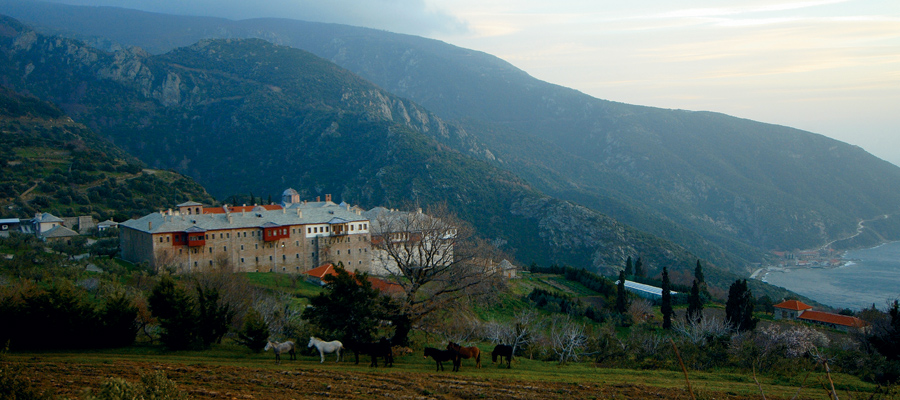Xiropotamou monastery
It is one of the oldest in Athos and is located 45 minutes from Daphne in the southwestern side of the peninsula. It was named after a nearby dry river (xiropotamos). According to tradition, it was founded in 424 by Pulcheria, the sister of emperor Theodosios Mikros, but written sources indicate that it was founded in 924 by monk Paul, who built it with the contribution of Romanos A the Lekapinos. In 956, it received a great donation of properties from a protospathario named John. Its floorishing period was violently interrupted in the 13th century, when it was raided by Frank pirates. At that time it seems to had been dedicated to the Forty Martyrs. It was renovated by Andronicus II Palaiologos, but was once again burnt in 1507, and then it was the turn of Sultan Selim A to award privileges and support it.
The current building complex is dated in 18th century. The Catholicon had been built between 1761 and 1763 by scholar Skopelan monk, Kaisarios Daponte, with funds from the rulers near Danube. The frescoes were made in 1783 and display scenes from the New Testament in the main church scenes from the Old Testament in the inner narthex and scenes from the Apocalypse in the narthex. There is an excellent wood-carved, gold-plated “iconostasio” chancel with floral decoration. According to tradition, the temple’s sanctuary has the largest part of the Holy Cross in the world. The altar was hagiographed in 1859 by Arsenios and Nikephoros. There are 16 chapels in total, 5 of which have no murals.
An interesting event in its long history is worth mentioning. A Turkish military division remained in the monastery until 1829, during the 1821 Revolution. When the war ended, the monks returned and toured with the Holy Cross and the remains of the Holy Forty Martyrs to the rulers of nearby Dunabe, in order to raise enough funds to restructure the buildings. The famous tray named “bottle of Pulcheria”, a masterpiece of Byzantine miniatures made of steatite stone stands out from the many valuable artifacts located in the sacristy. The library has 409 manuscripts, 20 of which in a parchment, and 5.000 books.
Text: Dr. Antonios G. Dikaios/ Theologian – Environmentalist.






